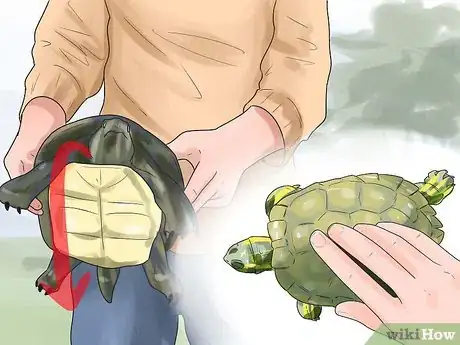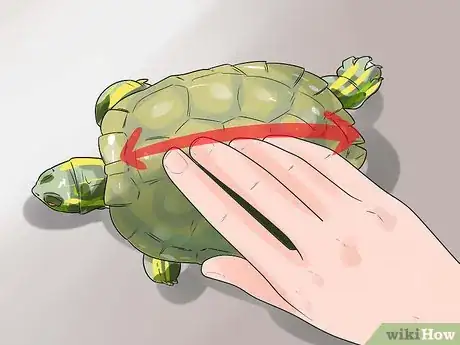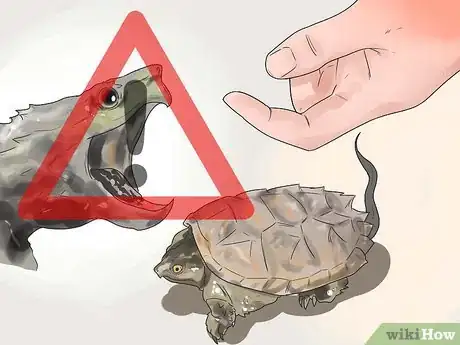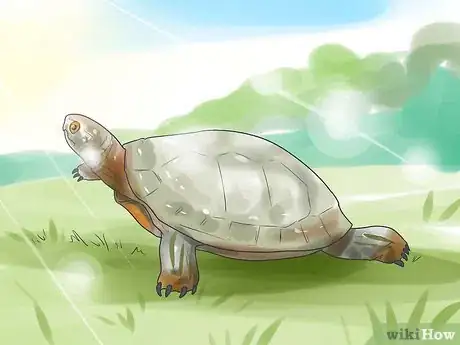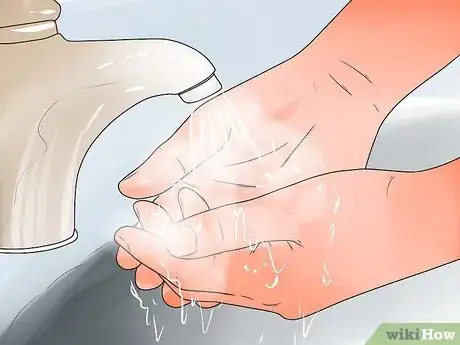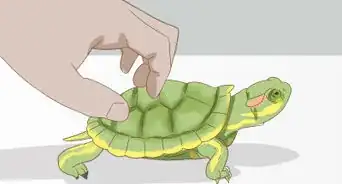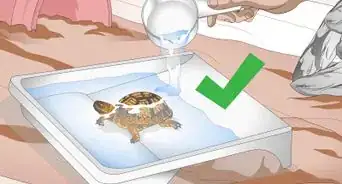This article was co-authored by Pippa Elliott, MRCVS. Dr. Elliott, BVMS, MRCVS is a veterinarian with over 30 years of experience in veterinary surgery and companion animal practice. She graduated from the University of Glasgow in 1987 with a degree in veterinary medicine and surgery. She has worked at the same animal clinic in her hometown for over 20 years.
wikiHow marks an article as reader-approved once it receives enough positive feedback. This article received 27 testimonials and 92% of readers who voted found it helpful, earning it our reader-approved status.
This article has been viewed 512,718 times.
Turtles are arguably the cutest of all of the reptiles. Because of this, they are often desirable pets. However, turtles don’t really enjoy being handled and petted the same way other domestic animals do.[1] This makes petting them a little trickier. For those of you who own a pet turtle/tortoise, this is how to pet one without injuring the turtle.
Steps
Petting a Turtle
-
1Approach from the front. If the turtle cannot see you and suddenly your hand appears, it may get frightened and bite you. Always approach a turtle from the front so that it can see you.
-
2Place turtles on a low, flat surface. Turtles will be the most receptive to human interaction when they feel safe and secure, so place them on the floor (preferably tile rather than carpet) when petting them.Advertisement
-
3Pet the top of the head. Gently run your finger on the middle-top of the turtle's head, carefully avoiding the nose/eyes.
- If the turtle repeatedly throws its head up in the air with its mouth open, it is trying to let you know that it does not like you touching its head.
-
4Pet the chins and cheeks. Use your finger to gently rub the turtle under the chin and along the cheeks.
-
5Massage the neck. Once a turtle trusts you, you may be able to massage its neck without causing it to withdraw into its shell.
-
6Pet your turtle’s shell. Turtles can feel touch through their shells. As such, stroke your turtle's shell in slow circles or run your fingers in straight lines along the length of its shell.[2]
- As an alternative to petting a turtle’s shell with your fingers, you can also gently rub a toothbrush or other soft-bristled brush along the top of its shell.
-
7Enjoy some turtle lap time. As an alternative to petting the turtle, you can enjoy bonding with it by allowing it crawl on you or sit in your lap. Just make sure it doesn’t fall off.
- Turtles will urinate when you pick them up, so use caution when putting them on your body.
-
8
Handling Turtles
-
1Know the risks. Turtles are not commonly thought of as dangerous animals capable of inflicting harm on human beings. However, a few breeds of turtles, particularly snapping turtles, are capable of inflicting a painful and potentially damaging bite. Also, turtles carry a number of diseases that can be harmful to humans. Turtle skin often has salmonella bacteria on it, which can make humans very sick.
- Salmonella can't be washed or rinsed off the turtle.
- Never leave a child to handle a turtle unattended.
-
2Be patient. Just because you acquired a pet turtle does not make that turtle a domesticated animal. Unlike some cats and dogs, who will naturally seek affection from humans, turtles tend to view humans with hesitancy and fear. Because of this, you need to be patient with your turtle. It may take a very long time before the turtle learns to recognize and trust you as its caregiver.[5]
-
3Handle with care. Turtles seem inherently rugged and tough because of their shells. However, the exposed legs and head can be easily damaged if the turtle is mishandled. Some tips for handling turtles with caution are:
- Try to avoid picking up or handling the turtle unless necessary. When you do need to pick a smaller turtle up, place your open palm under its plastron (or bottom shell/ belly) and make sure its legs can touch your hand. In the wild, turtles don’t spend much, if any, of their time off of the ground. Having your hand underneath the turtle should make it more comfortable.[6]
- Always lift turtles up from the back and not the front. Turtles are unpredictable and lifting the turtle from the front will give it an opportunity to bite you. Turtles may urinate when being picked up, which is yet another reason why you should wear gloves when handling them.[7]
- Don’t place turtles on the edges of high surfaces. They are not always aware of their environment and may walk right off the edge, injuring themselves.[8]
- As a general rule, it is not wise to touch a turtle’s legs or claws.
- Remember, turtle shells are not invincible. Some turtles have soft shells that can be easily scratched or damaged, leading to fungal infections. Even hard shelled turtles can sustain damage to or break their shells- so be careful.[9]
-
4Consider the temperature. Turtles are more energetic, aware and receptive when they are warm. Cold turtles are much more likely to shy away from external stimuli because they are not entirely sure what is going on around them. The best time to pet or handle a turtle is after it has been sunning itself or lying under a heat lamp.
- Turtles need real sunlight, not just heat lamps or artificial sunlight. A lack of sunlight can lead to metabolic bone disease, which essentially disintegrates a turtle’s bones.
-
5Understand turtle communication. Turtles are not the most communicative animals around. However, there are a few physical signs that your turtle is not in the mood for human contact. They include:
- Hissing
- Sitting motionless with the mouth open
- Withdrawing into the shell
- Snapping or biting gestures
-
6Practice proper hygiene. Always wash your hands after handling a turtle, as there are diseases on their skin that are harmful to people. Most experts suggest handling turtles with gloves, although this would defeat the purpose of petting a turtle. Also, remember that turtles spend most of their time in dirt and dirty water, so it may be wise to rinse the turtle off before handling it.
Expert Q&A
Did you know you can get premium answers for this article?
Unlock premium answers by supporting wikiHow
-
QuestionCan a turtle feel its shell?
 Pippa Elliott, MRCVSDr. Elliott, BVMS, MRCVS is a veterinarian with over 30 years of experience in veterinary surgery and companion animal practice. She graduated from the University of Glasgow in 1987 with a degree in veterinary medicine and surgery. She has worked at the same animal clinic in her hometown for over 20 years.
Pippa Elliott, MRCVSDr. Elliott, BVMS, MRCVS is a veterinarian with over 30 years of experience in veterinary surgery and companion animal practice. She graduated from the University of Glasgow in 1987 with a degree in veterinary medicine and surgery. She has worked at the same animal clinic in her hometown for over 20 years.
Veterinarian
-
QuestionCan a turtle's skin really harm me with salmonella?
 Pippa Elliott, MRCVSDr. Elliott, BVMS, MRCVS is a veterinarian with over 30 years of experience in veterinary surgery and companion animal practice. She graduated from the University of Glasgow in 1987 with a degree in veterinary medicine and surgery. She has worked at the same animal clinic in her hometown for over 20 years.
Pippa Elliott, MRCVSDr. Elliott, BVMS, MRCVS is a veterinarian with over 30 years of experience in veterinary surgery and companion animal practice. She graduated from the University of Glasgow in 1987 with a degree in veterinary medicine and surgery. She has worked at the same animal clinic in her hometown for over 20 years.
Veterinarian Yes. Turtles and other reptiles are common carries of the salmonella bug. This means they can be infected but not ill, but a person who handles the turtle and doesn't wash their hands can become sick. It's important to observe scrupulous hygiene when you own a turtle, wash your hands after handling, and regularly disinfect the area around the tank, door handles, and any surfaces you might touch whilst handling the reptile.
Yes. Turtles and other reptiles are common carries of the salmonella bug. This means they can be infected but not ill, but a person who handles the turtle and doesn't wash their hands can become sick. It's important to observe scrupulous hygiene when you own a turtle, wash your hands after handling, and regularly disinfect the area around the tank, door handles, and any surfaces you might touch whilst handling the reptile. -
QuestionIs it safe for my 10 year old child to pet a turtle?
 Pippa Elliott, MRCVSDr. Elliott, BVMS, MRCVS is a veterinarian with over 30 years of experience in veterinary surgery and companion animal practice. She graduated from the University of Glasgow in 1987 with a degree in veterinary medicine and surgery. She has worked at the same animal clinic in her hometown for over 20 years.
Pippa Elliott, MRCVSDr. Elliott, BVMS, MRCVS is a veterinarian with over 30 years of experience in veterinary surgery and companion animal practice. She graduated from the University of Glasgow in 1987 with a degree in veterinary medicine and surgery. She has worked at the same animal clinic in her hometown for over 20 years.
Veterinarian The FDA advise that turtles are common carriers of salmonella. Infection with the latter can be serious, especially in children, the elderly or those with a weak immune system. It is essential that any child is supervised with a turtle and be vigilant for the child putting a finger in their mouth, or even touching their hair (as the salmonella could be transferred to hair which the child then sucks.) If you want to be totally safe then a 10-year old should not pet a turtle, but at the very least ensure they wash their hands afterwards and don't put anything in their mouth.
The FDA advise that turtles are common carriers of salmonella. Infection with the latter can be serious, especially in children, the elderly or those with a weak immune system. It is essential that any child is supervised with a turtle and be vigilant for the child putting a finger in their mouth, or even touching their hair (as the salmonella could be transferred to hair which the child then sucks.) If you want to be totally safe then a 10-year old should not pet a turtle, but at the very least ensure they wash their hands afterwards and don't put anything in their mouth.
Warnings
- Unless you are a trained expert, never try to pet a snapping turtle. Snapping turtles have an incredibly powerful bite and can be quite aggressive.⧼thumbs_response⧽
- Never attempt to handle or pet wild turtles.⧼thumbs_response⧽
- Turtles are not always the type of pet that likes to be handled. Some turtles will spend their entire lives around human care takers and still not be receptive to human affection.⧼thumbs_response⧽
References
- ↑ http://www.petplace.com/article/reptiles/general/enjoying-your-reptile/how-to-handle-turtles-and-tortoises
- ↑ http://www.petplace.com/article/reptiles/general/enjoying-your-reptile/how-to-handle-turtles-and-tortoises
- ↑ http://www.petplace.com/article/reptiles/general/enjoying-your-reptile/how-to-handle-turtles-and-tortoises
- ↑ http://www.petplace.com/article/reptiles/general/enjoying-your-reptile/how-to-handle-turtles-and-tortoises
- ↑ http://www.petplace.com/article/reptiles/general/enjoying-your-reptile/how-to-handle-turtles-and-tortoises
- ↑ http://www.petplace.com/article/reptiles/general/enjoying-your-reptile/how-to-handle-turtles-and-tortoises
- ↑ http://www.petplace.com/article/reptiles/general/enjoying-your-reptile/how-to-handle-turtles-and-tortoises
- ↑ http://www.petplace.com/article/reptiles/general/enjoying-your-reptile/how-to-handle-turtles-and-tortoises
- ↑ http://www.petplace.com/article/reptiles/general/enjoying-your-reptile/how-to-handle-turtles-and-tortoises
About This Article
To pet a turtle, first place it on a low, flat surface so it feels safe. Then, approach it from the front so you don’t scare it. You can gently pet your turtle on the top of its head, on its cheeks, and under its chin using your finger. Turtles can actually feel through their shells, so you can also pet it by stroking its shell with your fingers. It might be more energetic and receptive when it’s warm, so try petting it after it’s done sunning itself. It may take some time for your turtle to warm up to you and like being pet, so be patient and gentle when handling it. Remember to wash your hands after handling your turtle and avoid petting aggressive turtles, like snapping and softshell turtles, since they can bite and cause serious injury. For tips from our Veterinary reviewer on how to make handling safer for you and the turtle, keep reading!

